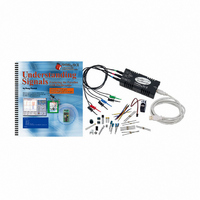28119 Parallax Inc, 28119 Datasheet - Page 7

28119
Manufacturer Part Number
28119
Description
KIT UNDERSTANDING SIGNALS
Manufacturer
Parallax Inc
Datasheet
1.28119.pdf
(137 pages)
Specifications of 28119
Lead Free Status
Contains lead
Accessory Type
Oscilloscope
Interface Type
USB
For Use With/related Products
BASIC Stamp® 2 and Board of Education
Lead Free Status / Rohs Status
Lead free / RoHS Compliant
Available stocks
Company
Part Number
Manufacturer
Quantity
Price
Company:
Part Number:
281197-2
Manufacturer:
TE
Quantity:
20 000
Company:
Part Number:
281197-2
Manufacturer:
MOLEX
Quantity:
2 500
Preface
This text demonstrates how to use the OPTAscope 81M as an oscilloscope by viewing
common signals generated by sensors and the Parallax BASIC Stamp. Most of the
circuits and examples used in this guide are drawn from other Parallax Stamps in Class
educational texts: What’s a Microcontroller?, Basic Analog and Digital and Applied
Sensors.
Students completing this text should be able to accomplish the following:
Signals and waveforms are discussed throughout the Stamps in Class series, but truly
understanding their form and speed requires capturing and viewing the signals on an
oscilloscope. The knowledge gained will allow students to take the leap from using pre-
written BASIC Stamp code to using a datasheet to develop their own synchronous serial
code, or even to choosing resistive sensors most suitable for their own projects. Viewing
the signals that power servos can lead students to better understanding and utilization of
programming techniques used for robotics and control systems applications.
The OPTAscope 81M is a low-cost, USB-based oscilloscope made by Optimum Designs.
Parallax generally has kept the hardware kits for the Stamps in Class texts under one
hundred dollars (excluding robots), but the OPTAscope 81M provides a great opportunity
to support the texts and complete students’ electronic kits at a relatively low cost.
The OPTAscope is a small, affordable oscilloscope that can help students to create and
work with advanced electronic systems. Even if students have used an oscilloscope once
or twice before, these OPTAscope 81M exercises will provide a greater understanding of
oscilloscopes as tools and of electronics in general. This in turn will enhance the
•
•
•
•
•
•
Configure an oscilloscope to trigger and capture a signal.
Measure waveform frequency and amplitude for single and dual sine waves.
View a repetitive signal as it is changed using BASIC Stamp code or by varying
sensor inputs.
Understand the differences between synchronous and asynchronous serial
signals.
Know two common uses of Operational Amplifiers (op-amps).
Make viewable infrared communication from handheld remote controls.





















